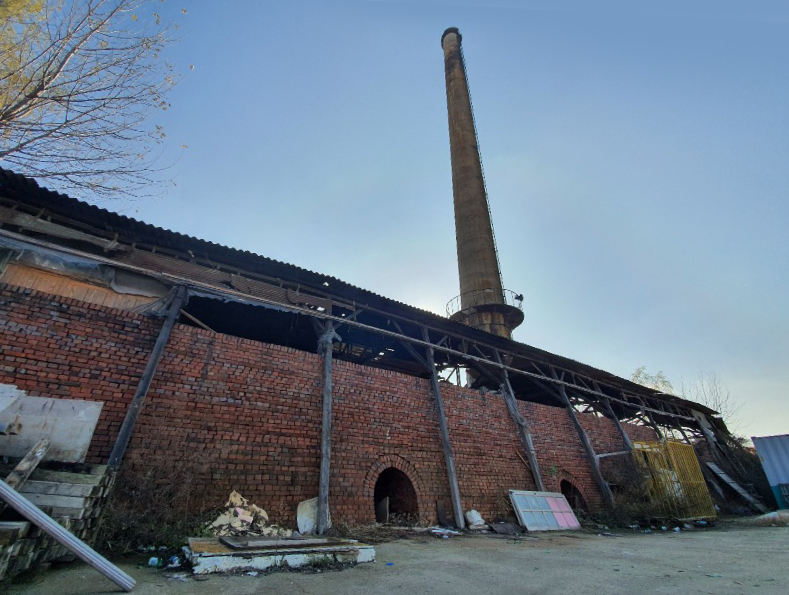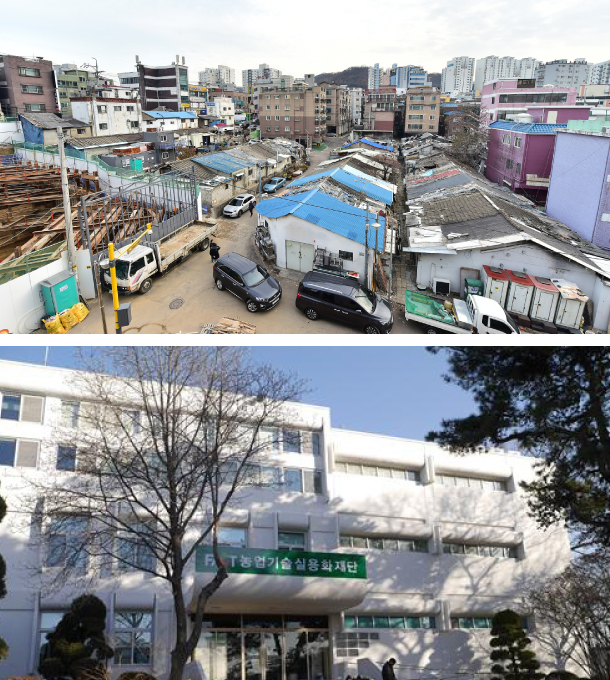Cities mull whether to keep aging historic sites: As districts across Korea redevelop, debates rage over what is still important

Yeongshin Yeonwa, a brickworks factory located in Suwon, Gyeonggi, may be demolished if the city government decides to go through with an urban development plan that scraps the building. The factory is presumed to have been built in the 1960s. [CHOI MO-RAN]
Yeongshin Yeonwa, a brick factory in the Gyeonggi city of Suwon, is one of them.
“The building is one the oldest in the city,” a resident told the JoongAng Ilbo, an affiliate of the Korea JoongAng Daily. “All the other ones built in the industrial era of Korea are gone.”
The factory closed down in the 1980s, according to the local registry of Gosaek-dong, where the factory is located. But the kiln used at the factory for brickworks, an open-air storage yard, a warehouse and lodging facilities for workers are mostly intact.
But not for long, according to city plans.
The 248,310 square-meter (2.7 million square-foot) area in Gosaek-dong was designated by the Suwon city government in 2012 to be redeveloped into a more modern and clean district for residential space. The area was 50 percent residential at the time and was occupied by older buildings and apartments in general.
“We thought about leaving Yeongshin Yeonwa as it is, but reached the conclusion that it is a stumbling block to the urban development plan,” an official of the Suwon city government told the JoongAng Ilbo. “The factory is not exactly the prettiest building in town, and some want to get rid of it for the sake of the area’s look. But there are others that say we ought to preserve the space for the history it carries. We’re mulling over what to do.”

Top: Houses in Incheon that used to be lodging for forced laborers during the Japanese occupation of Korea (1910-1945). Above: The former library of the Rural Development Administration, built in 1967, was torn down last year. [BUPYEONG DISTRICT OFFICE, OFFICE OF REP. SOHN HYE-WON]
A set of houses - disheveled and unoccupied - stand out among higher buildings in a neighborhood of Bupyeong District, Incheon.
They are the lodgings once occupied by forced laborers during the Japanese occupation of Korea (1910-1945). Hironaka Shoko, a Japanese machine parts company, created these lodgings, which were bought by Mitsubishi Steel Manufacturing in 1942.
There were nine houses left by early 2019. That summer, Bupyeong District Office decided to demolish three of them after some residents complained they were ugly and were a negative influence to the local housing market.
Some scholars argued at the time that the houses, if preserved, could be developed into tourist sites.
According to JoongAng Ilbo’s recent conversation with the district office, they intend to scrap four more houses and devise a way to preserve the remaining two.
In other areas still, some historic buildings have already been scrapped clean.
A Japanese house that was built in 1938 in Changwon, South Gyeongsang, was torn down in May last year to make way for a five-story building.
In some cases, the local district office buys the buildings to preserve them.
The Suwon city government bought a building that was occupied by the Japanese in 1916 and was used by the Japanese government, mainly to collect information on the local harvest and to send food to Japan.
The building was used as a local court from 1952 to 1956, then as a district education office until 1963, when it was turned into a public office for a local political party in the 1970s.
The building was bought by an individual in 1981 and was used as a hospital and as a printing shop until 2015, when the local district office mulled over a request by the owner to tear it down to build a more modern building in its place.
The Suwon city government stepped in and bought the building from the owner, turning it into a local museum of sorts, with exhibitions held inside about the modern history of Suwon.
Some civic groups have called for more government intervention to preserve historical spaces across the country.
“The structures from modern Korean history show the identity of a city or a district and where its roots are,” said Min Woon-ki, a civic group promoting fair development of public spaces in Incheon. “It will be best if local governments can buy them and preserve them, but if that’s not possible for various reasons, they ought to at least try to preserve these spaces by engaging the residents and experts in dialogue.”
Some local district offices have torn down these spaces but have turned over pieces of these historical sites to a local museum. It’s not a bad idea, but the situation could be better, according to some experts.
“It’s not easy to find a place to preserve these pieces in their best state,” said Sohn Jang-won, professor of architectural studies at JEI University in Incheon. “Instead of bulldozing these places and handing parts of what’s left over to a museum, it would be best if these spaces can be preserved and turned into a location that residents can continue to access and use.”
BY CHOI MO-RAN, SHIM SEOK-YONG [chung.juhee@joongang.co.kr]
경기도 수원시 고색동에는 아파트 10층 높이(25m)의 기다란 굴뚝이 하나 솟아있다. 1960년대에 지은 것으로 추정되는 벽돌공장 ‘영신연와(永新煉瓦)’다. 공장은 1980년대 문을 닫았지만, 벽돌을 굽던 가마터와 야적장, 창고, 노동자 숙소 등 옛 모습은 그대로 남아있다. 주민들은 이곳이 “수원에 남은 유일한 초기 산업 건축물”이라고 말한다.
하지만 영신연와는 철거될 위기다. 이 일대에서 고색지구 도시개발 사업이 추진되면서부터다. 수원시 관계자는 “영신연와를 놔두는 방안을 검토했으나 개발을 추진하는 조합에서 미관을 해치거나 개발의 걸림돌이 될 수 있다며 반대하고 있어 고민”이라면서 “보존할 필요가 있다는 의견도 많아 기록화 작업 등 대안을 검토하고 있다”고 말했다.
이런 취급을 받고 있는 근현대 건축물은 영신연와만이 아니다. ‘오래되고 낡았다’는 인식과 ‘역사적 의미가 있으니 보존해야 한다’는 의견도 부딪쳐 곳곳에서 논란이 일고 있다.
인천시 부평동에 있는 미쓰비시(三菱) 줄사택이 대표적이다. 1938년 히로나카상공(弘中商工)이 노동자 숙소로 만들었고, 1942년 미쓰비시 제강이 인수했다. 사택이 줄지어 있다고 해서 줄사택이라 불렸다. 이후 차례로 철거돼 현재는 6채가 남았다. 주민들은 흉물이라며 철거를 요구하지만, 학계에선 일제 강제노역의 흔적을 보존해야 한다는 주장이 나온다. 결국 부평구는 4채는 철거하고 나머지 두 채는 활용방안을 찾고 있다. 철거되는 사택 일부 동을 실측 조사한 뒤 기록화 보고서를 남겨 다른 장소에서 복원하는 방안을 검토 중이다.
이미 사라진 건축물도 부지기수다.
지난해 5월에는 경남 창원시에서 1938년에 건립된 일본식 집인 ‘이애숙 가옥’이 헐렸다. 그 자리에는 5층 상가 건물이 들어설 예정이다. 지난해 11월에는 1974년부터 목선 건조와 수리에 쓰는 철제 못 등을 만들던 대장간인 신일철공소가 철거됐다.
근현대 건축물이 사라지는 이유는 주로 개발 논리다. 낡고 오래된 건물을 유지하는 것보다 새 건물을 짓는 것이 경제적으로 이득이기 때문이다. 개인 소유 건축물에 대해선 역사적 의미가 있더라도 지방자치단체 등이 철거 문제에 개입할 명분이 마땅찮다.
이에 일부 지자체는 개인 소유 건물을 사 복원하기도 한다. 1923년 건립된 수원시 부국원(富國園)은 한국전쟁 이후 검찰 임시청사, 수원교육청 등으로 활용됐다. 이후 철거 위기에 놓이자 수원시가 사들여 복원했다. 인천시는 지자체 등록문화재로 등록해 보존·활용하는 방안 등 조례 개정으로 지역 문화재 지키기에 나서고 있다.
지자체가 나서서 근현대 건축물관리에 나서야 한다고 지적하는 시민단체들도 있다. 이들은 “지역 내 근현대 건축물을 파악해 보존할 가치가 있는 건물은 적극적으로 관리해야 한다”고 주장한다.
민운기 인천도시 공공성 네트워크 간사는 “근현대 건축물은 도시의 정체성을 구성하고 지역 구성원간 공감대를 형성하는 중요한 요소”라며 “이를 문화재로 등록해 현장을 보전하는 게 최선이지만, 현실적으로 어렵다면 주민·전문가 의견을 수렴해 최대한 보존하는 방안을 찾아야 한다”고 주장했다. 손장원 인천재능대 실내건축학과 교수도 “철거 후 다른 장소에 복원하는 방안은 쉽지 않고 그 가치가 퇴색될 수 밖에 없다”면서 “박물관에 보존하는 것보다는 주민들과 함께 어우러질 수 있는 방향으로 나아가는 것이 역사적 가치에 맞다”고 말했다.
최모란·심석용 기자 moran@joongang.co.kr










with the Korea JoongAng Daily
To write comments, please log in to one of the accounts.
Standards Board Policy (0/250자)